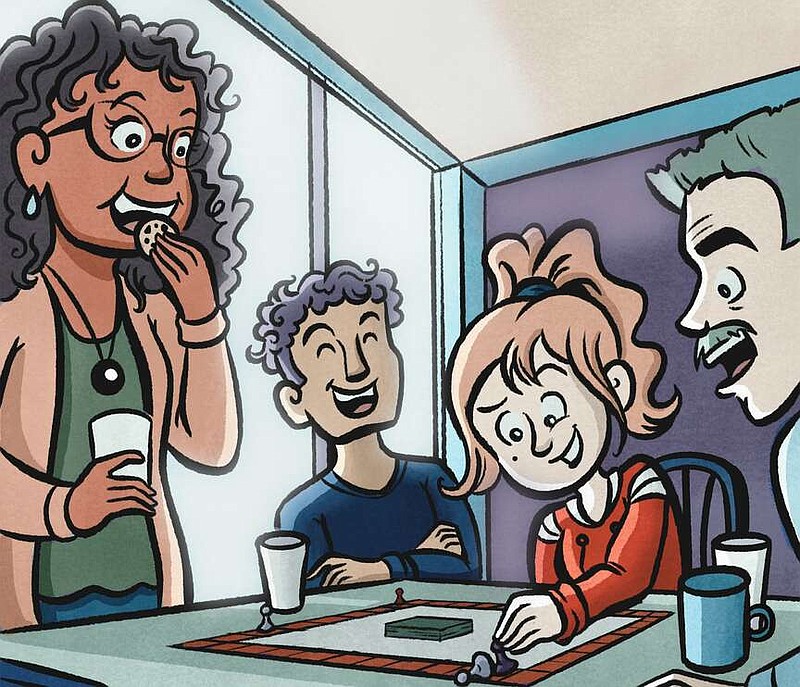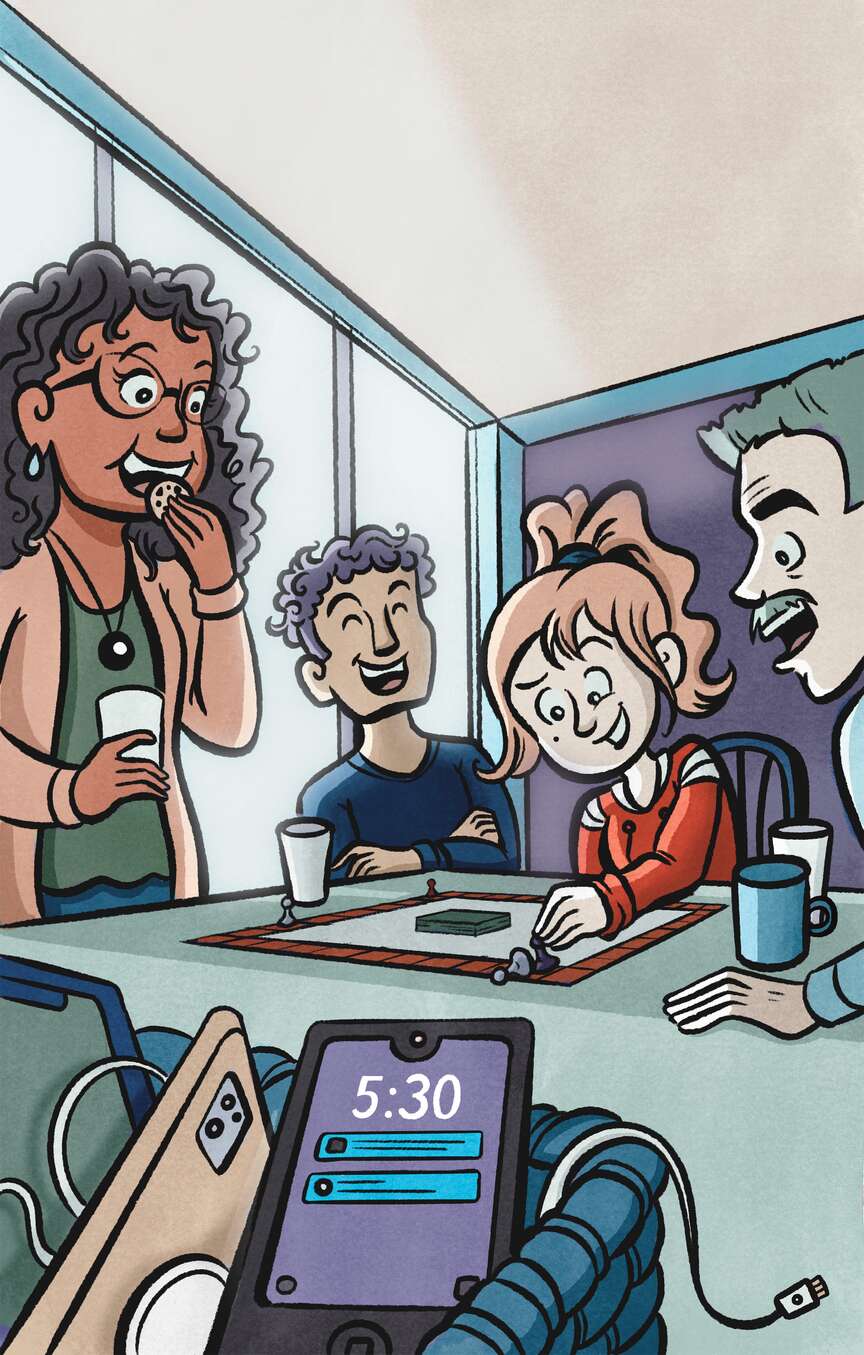When researchers last year tracked the smartphones of 200 volunteers aged 11 to 17, they found youngsters weren't just mindless screen zombies.
In fact, they used all sorts of strategies to try to disconnect: Some left on "do not disturb" to silence never-ending notifications. Others charged their phones outside their bedrooms to help them get sleep.
Turns out, teenagers want time away from phones and social media, too.
If it feels like everyone in your family is spending too much time looking at screens instead of each other, you're not alone. Giant corporations are working against all of us to make social media, games and apps ever harder to put down.
"There is not a generational decline in willpower," U.S. Surgeon General Vivek H. Murthy said. "The platforms are designed specifically to maximize how much time we spend on them."
The good news is that it's never too late for a family tech reset. But you won't find the solution only in parental controls and screen-time restrictions. The most effective approach is to listen to what your kids say about their online experiences and make rebalancing a project for the whole family. That includes parents taking a hard look at their own phone habits, too.
The four-step strategy we recommend below is based on interviews with doctors, parents and researchers who have studied what's actually going on behind kids' screens -- and seen what really works to change behavior. This is targeted primarily at families with teenagers who already have phones or other devices. (When to give kids their first phone or social media account is an important separate conversation.)
Parents have plenty of reason to be concerned about mental health, bullying and exploitation online. But try to remember: Screens aren't always the enemy, even if children are using them differently from how you grew up. Many teenagers find community online. For some, it's a constructive and even lifesaving place to explore identity.
That's why the first step is to practice more empathy and less eye-rolling.
AWKWARD CONVERSATION
Parents have never been teenagers in the age of TikTok and artificial intelligence. So before you launch into rulemaking, it's essential to do some fact-finding.
Talk to your teenager about his or her online life the same way you would talk about school or extracurriculars. Where do they like to spend time? What need does a particular app or game fulfill? What real-world activities do they value, and how can tech get in the way?
To get the conversation started, call a casual family meeting. Tell your child you want to hear their thoughts about the family's tech use -- what's going well, and where they could use your help. Make sure you're open to feedback about your tech use, as well.
Listen to what your kids already do on their own to tame their screen time. A good question: What do you do when you really want to focus on someone or something you care about?
Call out what researchers call "technoference": the moments when technology interferes with relationships and actual human connection.
As you process this information together, focus on building your understanding rather than immediately giving advice. Were you bullied as a teenager? Were you curious about sex and other topics that were "too mature" for you? Your child is not reinventing the wheel here.
While interviewing dozens of teenagers for their book "Behind Their Screens: What Teens Are Facing (and Adults Are Missing)," researchers Emily Weinstein and Carrie James were surprised to learn that many teenagers slept with their phones because they were worried about missing a text from a friend in crisis. If frustrated parents viewed the habit as simple "phone addiction," they would be missing out on an important part of their child's inner world, said Weinstein, the executive director of Harvard's Center for Digital Thriving.
Let the family meeting be sacred ground where teenagers can share without getting in trouble.
SCREEN TIME 'EXPERIMENTS'
Now you need an action plan. Critically, though, it shouldn't just be rules handed down by parents. Think of it, instead, as experiments.
As a family, brainstorm some ways to reclaim your time and focus from devices. Failure is OK.
The focus should be as much about reducing screen time as it is replacing that time with something you would like more of, be it family adventures or sleep. "We can't just expect that we're going to reduce screen time by an hour and things are just going to get better in our family," University of Michigan pediatrician Jenny Radesky says. "Then you just leave this vacuum of an hour where kids are going to be like, 'I'm bored, I don't know what to do.'"
Ideas from the experts include:
No devices out at meal times ever, so everyone gets to look at each other.
When you're hanging out, have everyone put their phone in a stack in the middle of the table, with some silly consequence for the person who looks first.
No devices out in the car, so you can have conversations instead.
No devices in or by the bed at night, so it's easier to sleep. Instead, charge them in a common space in the home.
Set the house WiFi router to shut off data access at an agreed time each night.
Try listening to an audiobook or podcast together.
Pick a vacation destination that's fun for everyone, but agree in advance you won't carry your phones with you -- or just pick a place that has little or no cell and WiFi service.
And before you start, pick a date on the calendar to agree to all get back together and talk about how the experiments affected everyone's mood. Talk about how it felt without the "digital pacifier" of a screen to look at in moments of awkwardness or social uncertainty -- and whether it ended up giving you moments to connect.
AGREE ON RULES,
FOR PARENTS TOO
When you find some experiments that work, turn them into rules that everyone agrees on.
Together, write a family tech plan (like these samples from Common Sense Media). Kids tend to know what's right and wrong, and you can help them fill in the blanks.
Then you have to follow the rules, too. "Parents are the number one role models for their kids when it comes to technology," says Jim Steyer, the founder of Common Sense Media.
If you're not present and engaged, why should your child be? They see you when you're answering work Slacks while they are telling you about their day, or texting while you're driving. In 2023, American adults used their phones an average of 4.3 hours per day, according to research firm Data.ai.
If you do need to pick up your phone during a communal moment for important grown-up reasons, say out loud why you're doing so -- like, "I'm looking up directions right now."
REVIEW TOOLS TOGETHER
Most social media and gaming sites come with safety and privacy settings. And while they won't fix systemic issues with abuse and social media amplifying harmful information, they're worth a regular checkup.
Where possible:
Turn off the ability for people outside your teenager's friend circle to direct message, mention or tag them.
Turn profiles to private so your teen has to accept new friends before they can engage.
On TikTok and Instagram, turn off "stitch" or "remix" so strangers can't boost their videos to new audiences.
Admittedly, it's tough to keep tabs on your teenager's social media experience from the outside. Dozens of parental-monitoring tools promise to scan your child's messages for "inappropriate" content or feed you updates on their activity. Some parents follow their kids online from secret accounts -- or just poke around teens' phones when they're not looking.
Our experts agree that surveilling a teen who isn't already in deep crisis can do more harm than good. Even if you don't trust them, it's important they trust you, Radesky says. Instead of spying, tell your teen exactly what you will do to stay apprised of their online life, and where you will grant them privacy.
Most importantly, help teenagers identify what behavior is acceptable. Brainstorm together what type of online flirtation is appropriate. Discuss what they would do if someone made them feel uncomfortable, guilty, scared or attacked. And make yourself available to gut check their posts before they hit send.
The body can be a useful tool here. Help kids learn to take signals from their bodies by modeling it yourself. "Wow, time on that app really made me feel energized," or "Gosh, my chest feels really anxious after watching that video."
If you're tired of constantly playing "bad cop" with your teen's tech use, we've got some good news: Striking the right balance is challenging for you both, and you can navigate this new world as a team.


